Göbekli Tepe
Göbekli Tepe Turkish: [ɡøbe̞kli te̞pɛ] ("Potbelly Hill") is a
Neolithic hilltop sanctuary erected at the top of a mountain ridge in
the Southeastern Anatolia Region of Turkey, some 15 kilometers (9 mi)
northeast of the town of Şanlıurfa (formerly Urfa / Edessa). It is the
oldest known human-made religious structure. The site was most
likely erected in the 10th millennium BCE and has been under excavation
since 1994 by German and Turkish archaeologists. Together with Nevalı
Çori, it has revolutionized understanding of the Eurasian Neolithic.
Göbekli
Tepe is located in southeastern Turkey. It was first noted in a survey
conducted by Istanbul University and the University of Chicago in 1964,
which recognized that the hill could not entirely be a natural feature
and postulated that a Byzantine cemetery lay beneath. The survey noted a
large number of flints and the presence of limestone slabs thought to
be Byzantine grave markers. This work was first mentioned in print in
Peter Benedict's article "Survey Work in Southeastern Anatolia" (1980).
In 1994, archaeologist Klaus Schmidt of the German Archaeological
Institute of Istanbul noted Benedict's article and visited the site,
recognizing that it was in fact a much older Neolithic site. Since
1995 excavations have been conducted by the German Archaeological
Institute of Istanbul and the Şanlıurfa Museum, under the direction of
Schmidt (University of Heidelberg 1995--2000, German Archaeological
Institute 2001--present). The hill had been under agricultural
cultivation before being excavated. Generations of local inhabitants had
frequently moved rocks and placed them in clearance piles and much
archaeological evidence may have been destroyed in the process. Scholars
from the Hochschule Karlsruhe began documenting the architectural
remains and soon discovered T-shaped pillars facing south-east. Some of
these pillars had apparently undergone attempts at destruction, probably
by farmers who mistook them for ordinary large rocks.

Göbekli Tepe on National Geography
Göbekli Tepe
Joe Rogan and Duncan Trussell talk about ancient cataclysms and the Göbekli Tepe ruins. Audio from The Joe Rogan Experience Podcast. Animated by Paul Klawiter- www.KlawiterStudios.com
Gobekli Tepe Stone Circles
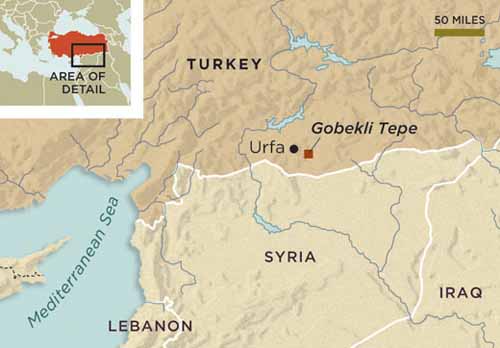
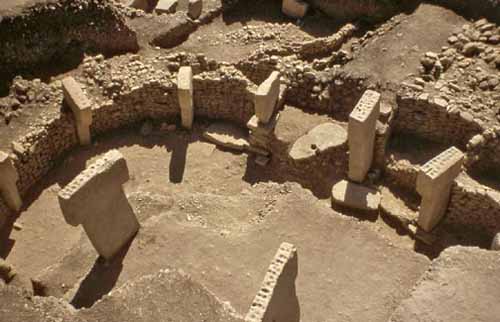
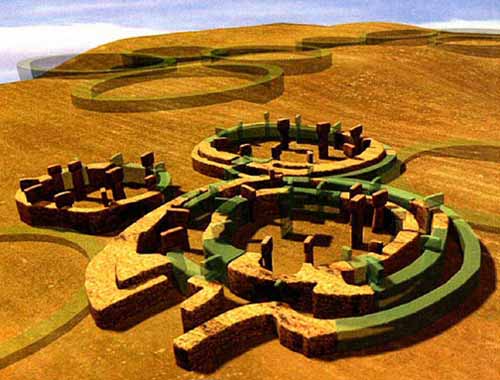
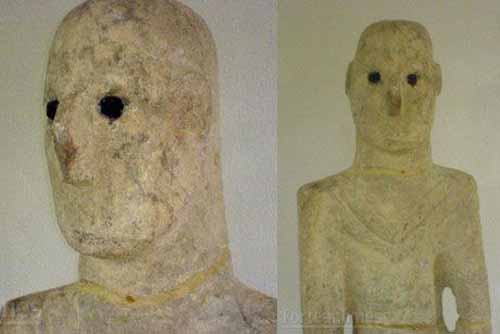
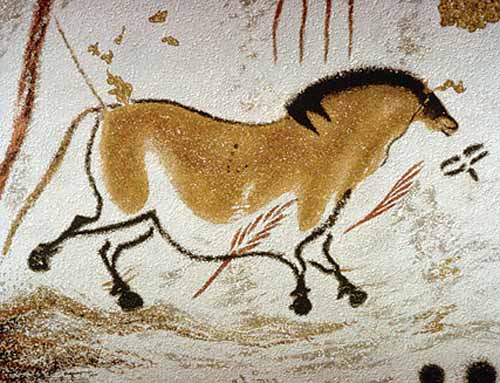
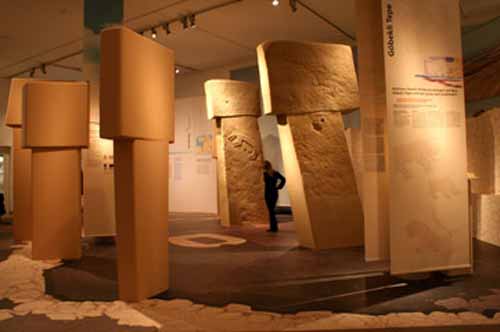
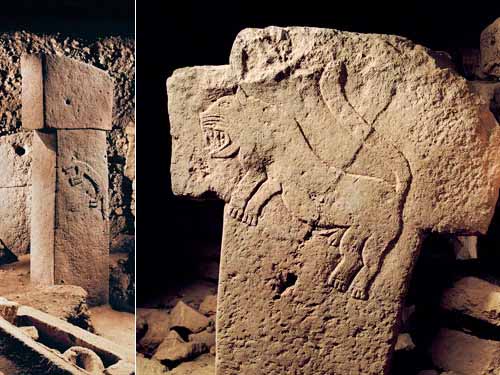
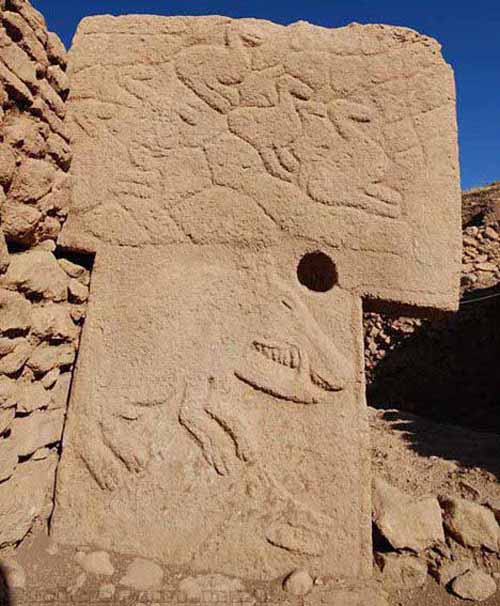
Disclose.tv - Ancient Aliens: Unexplained Structures pt 1/3
Gobekli Tepe (Turkish for "Hill with a potbelly") is a hilltop sanctuary
erected on the highest point of an elongated mountain ridge some 15 km
northeast of the town of Sanliurfa(formerly Urfa / Edessa) in
southeastern Turkey. The site, currently undergoing excavation by German
and Turkish archaeologists, was erected by hunter-gatherers in the 10th
millennium BC (ca. 11,500 years ago), before the advent of sedentism.
Mysteriously, the entire complex of stones, pillars and carvings was
then deliberately buried in 8000 BC. Together with Nevalõ Cori, it has
revolutionized understanding of the Eurasian Neolithic.
Gobekli Tepe is located in southeastern Turkey. It had already been
noted in an American survey in 1964, which recognized that the hill
could not entirely be a natural feature, but assumed that a Byzantine
cemetery lay beneath. Since 1994 excavations have been conducted by the
German Archaeological Institute (Istanbul branch) and Sanliurfa Museum,
under the direction of the German archaeologist Klaus Schmidt
(1995Ð2000: University of Heidelberg; since 2001: German Archaeological
Institute). Schmidt says that the stone fragments on the surface made
him aware immediately that the site was prehistoric. Before then, the
hill had been under agricultural cultivation; generations of local
inhabitants had frequently moved rocks and placed them in clearance
piles; much archaeological evidence may have been destroyed in the
process. Scholars from the Hochschule Karlsruhe began documenting the
architectural remains. They soon discovered T-shaped pillars, some of
which had apparently undergone attempts at smashing.
The Complex
Gobekli Tepe is the oldest human-made place of worship yet discovered.
Until excavations began, a complex on this scale was not thought
possible for a community so ancient. The massive sequence of
stratification layers suggests several millennia of activity, perhaps
reaching back to the Mesolithic. The oldest occupation layer (stratum
III) contains monolithic pillars linked by coarsely built walls to form
circular or oval structures. So far, four such buildings, with diameters
between 10 and 30m have been uncovered. Geophysical surveys indicate
the existence of 16 additional structures.
Stratum II, dated to Pre-Pottery Neolithic B (PPNB) (7500-6000 BC), has
revealed several adjacent rectangular rooms with floors of polished
lime, reminiscent of Roman terrazzo floors. The most recent layer
consists of sediment deposited as the result of agricultural activity.
The monoliths are decorated with carved reliefs of animals and of
abstract pictograms. The pictograms cannot be classed as writing, but
may represent commonly understood sacred symbols, as known from
Neolithic cave paintings elsewhere. The carefully carved figurative
reliefs depict lions, bulls, boars, foxes, gazelles, asses, snakes and
other reptiles, insects, arachnids, and birds, particularly vultures and
water fowl. At the time the shrine was constructed the surrounding
country was much lusher and capable of sustaining this variety of
wildlife, before millennia of settlement and cultivation resulted in the
nearÐDust Bowl conditions prevailing today.
Vultures also feature in the iconography of the Neolithic sites of
‚atalhoyuk and Jericho; it is believed that in the early Neolithic
culture of Anatolia and the Near East the deceased were deliberately
exposed in order to be excarnated by vultures and other birds of prey.
(The head of the deceased was sometimes removed and preserved - possibly
a sign of ancestor worship.) This, then, would represent an early form
of sky burial.
Few humanoid forms have surfaced at Gobekli Tepe but include a relief of
a naked woman, posed frontally in a crouched position, that Schmidt
likens to the Venus accueillante figures found in Neolithic north
Africa; and of at least one decapitated corpse surrounded by vultures.
Some of the pillars, namely the T-shaped ones, have carved arms, which
may indicate that they represent stylized humans (or anthropomorphic
gods). Another example is decorated with human hands in what could be
interpreted as a prayer gesture, with a simple stole or surplice
engraved above; this may be intended to represent a temple priest.
Architecture
The houses or temples are round megalithic buildings. The walls are made
of unworked dry stone and include numerous T-shaped monolithic pillars
of limestone that are up to 3 m high. Another, bigger pair of pillars is
placed in the centre of the structures. There is evidence that the
structures were roofed; the central pair of pillars may have supported
the roof. The floors are made of terrazzo (burnt lime), and there is a
low bench running along the whole of the exterior wall.
The reliefs on the pillars include foxes, lions, cattle, wild boars,
wild asses, herons, ducks, scorpions, ants, spiders, many snakes, and a
very few anthropomorphic figures. Some of the reliefs have been
deliberately erased, maybe in preparation for new designs. There are
freestanding sculptures as well that may represent wild boars or foxes.
As they are heavily encrusted with lime, it is sometimes difficult to
tell. Comparable statues have been discovered at Nevali Cori and Nahal
Hemar.
The quarries for the statues are located on the plateau itself; some
unfinished pillars have been found there in situ. The biggest unfinished
pillar is still 6.9 m long; a length of 9m has been reconstructed. This
is much larger than any of the finished pillars found so far. The stone
was quarried with stone picks. Bowl-like depressions in the limestone
rocks may already have served as mortars or fire-starting bowls in the
epipalaeolithic. There are some phalloi and geometric patterns cut into
the rock as well; their dating is uncertain.
While the structures are primarily temples, more recently smaller
domestic buildings have been uncovered. Despite this, it is clear that
the primary use of the site was cultic and not domestic. Schmidt
believes this "cathedral on a hill" was a pilgrimage destination
attracting worshipers up to a hundred miles distant.
Butchered bones
found in large numbers from local game such as deer, gazelle, pigs, and
geese suggest that ritual feasting (and perhaps sacrifice) were
regularly practiced here.
The site was deliberately backfilled sometime after 8000 BC: the
buildings are covered with settlement refuse that must have been brought
from elsewhere. These deposits include flint tools like scrapers and
arrowheads and animal bones. The lithic inventory is characterized by
Byblos points and numerous Nemrik-points. There are Helwan-points and
Aswad-points as well.
Chronological Context
All statements about the site must be considered preliminary, as only
about 5% of the site's total area has been excavated as yet; floor
levels have been reached in only the second complex (complex B), which
also contained a terrazzo-like floor. Schmidt believes that the dig
could well continue for another fifty years. So far excavations have
revealed very little evidence for residential use. Through the
radiocarbon method, the end of stratum III can be fixed at circa 9,000
BC (see above); its beginnings are estimated to 11,000 BC or earlier.
Stratum II dates to about 8,000 BC.
Archaeologist Ofer Ben-Yosef of Harvard has said he would not be
surprised if evidence surfaces proving slave labor was involved which
would also represent something of a first, since hunting-gathering
communities are traditionally thought to have been egalitarian and to
predate slavery. At any rate, it is generally believed that an elite
class of religious leaders supervised the work and later controlled
whatever ceremonies took place here. If so, this would be the oldest
known evidence for a priestly caste - much earlier than such social
distinctions developed elsewhere in the Near East.
Around the beginning of the 8th millennium BC "Potbelly Hill" lost its
importance. The advent of agriculture and animal husbandry brought new
realities to human life in the area, and the "stone-age zoo" (as Schmidt
calls it) depicted on the pillars apparently lost whatever significance
it had had for the region's older, foraging, communities. But the
complex was not simply abandoned and forgotten, to be gradually
destroyed by the elements. Instead, it was deliberately buried under 300
to 500 cubic metres of soil. Why this was done is unknown, but it
preserved the monuments for posterity.
Interpretation and Importance
Gobekli Tepe is regarded as an archaeological discovery of the greatest
importance, since it profoundly changes our understanding of a crucial
stage in the development of human societies. It seems that the erection
of monumental complexes was within the capacities of hunter-gatherers
and not only of sedentary farming communities as had been previously
assumed. In other words, as excavator Klaus Schmidt put it: "First came
the temple, then the city." This revolutionary hypothesis will have to
be supported or modified by future research.
Schmidt considers Gobekli Tepe a central location for a cult of the
dead. He suggests that the carved animals are there to protect the dead.
Though no tombs or graves have been found so far, Schmidt believes they
remain to be discovered beneath the sacred circles' floors. Schmidt
also interprets it in connection with the initial stages of an incipient
Neolithic. It is one of several neolithic sites in the vicinity of
Mount Karaca Dag, an area where geneticists suspect the origins of at
least some of our cultivated grains (see Einkorn). Such scholars suggest
that the Neolithic revolution, i.e., the beginnings of grain
cultivation, took place here. Schmidt and others believe that mobile
groups in the area were forced to cooperate with each other to protect
early concentrations of wild cereals from wild animals (herds of
gazelles and wild donkeys). This would have led to an early social
organization of various groups in the area of Gobekli Tepe. Thus,
according to Schmidt, the Neolithic did not begin at a small scale in
the form of individual instances of garden cultivation, but started
immediately as a large-scale social organisation ("a full-scale
revolution").
Not only its large dimensions, but the side-by-side existence of
multiple pillar shrines makes the location unique. There are no
comparable monumental complexes from its time. Nevali Cori, a well-known
Neolithic settlement also excavated by the German Archaeological
Institute, and submerged by the Ataturk Dam since 1992, is 500 years
later, its T-shaped pillars are considerably smaller, and its shrine was
located inside a village; the roughly contemporary architecture at
Jericho is devoid of artistic merit or large-scale sculpture; and
Catalhoyuk, perhaps the most famous of all Anatolian Neolithic villages,
is 2,000 years younger.
Schmidt has engaged in some speculation regarding the belief systems of
the groups that created Gobekli Tepe, based on comparisons with other
shrines and settlements. He assumes shamanic practices and suggests that
the T-shaped pillars may represent mythical creatures, perhaps
ancestors, whereas he sees a fully articulated belief in gods only
developing later in Mesopotamia, associated with extensive temples and
palaces.
This corresponds well with an ancient Sumerian belief that agriculture,
animal husbandry and weaving had been brought to mankind from the sacred
mountain Du-Ku, which was inhabited by Annuna-deities, very ancient
gods without individual names. Klaus Schmidt identifies this story as an
oriental primeval myth that preserves a partial memory of the
Neolithic. It is also apparent that the animal and other images give no
indication of organized violence, i.e., there are no depictions of
hunting raids or wounded animals, and the pillar carvings ignore game on
which the society mainly subsisted, like deer, in favor of formidable
creatures such as lions, snakes, spiders and scorpions.
At present, Gobekli Tepe raises more questions for archaeology and
prehistory than it answers. We do not know how a force large enough to
construct, augment, and maintain such a substantial complex was
mobilized and paid or fed in the conditions of pre-Neolithic society. We
cannot "read" the pictograms, and do not know for certain what meaning
the animal reliefs had for visitors to the site; the variety of fauna
depicted, from lions and boars to birds and insects, makes any single
explanation problematic.
As there seems to be little or no evidence of habitation, and the
animals depicted on the stones are mainly predators - with the exception
of gazelles, wild asses, insects and fowl - the stones may have been
intended to stave off evils through some form of magic representation.
Alternatively, they may have served as totems. It is not known why more
and more walls were added to the interiors while the sanctuary was in
use, with the result that some of the engraved pillars were obscured
from view. Burial may or may not have occurred at the site. The reason
the complex was eventually buried remains unexplained. Until more
evidence is gathered, it is difficult to deduce anything certain about
the originating culture.
 Gobekli Tepe
Gobekli Tepe Wikipedia
Gobekli Tepe Google Videos
In the News ...
'World's Oldest Temple' May Have Been Cosmopolitan Center Live Science - March 16, 2012
Ancient blades made of volcanic rock that were discovered at what may be
the world's oldest temple suggest that the site in Turkey was the hub
of a pilgrimage that attracted a cosmopolitan group of people some
11,000 years ago.
The researchers matched up about 130 of the blades, which would have
been used as tools, with their source volcanoes, finding people would
have come from far and wide to congregate at the ancient temple site,
Gobekli Tepe, in southern Turkey. The blades are made of obsidian, a
volcanic glass rich with silica, which forms when lava cools quickly. he
research was presented in February at the 7th International Conference
on the Chipped and Ground Stone Industries of the Pre-Pottery Neolithic
in Barcelona, Spain.
Only a tiny portion of Gobekli Tepe has been excavated so far, but what
has been unearthed has been hailed by archaeologists as astounding for
its great age and artistry.The site contains at least 20 stone rings,
one circle built inside another, with diameters ranging from 30 to 100
feet (10 to 30 meters). The researchers suspect people would fill in the
outer ring with debris before building a new circle within.
T-shaped limestone blocks line the circles, and at their center are two
massive pillars about 18 feet (5.5 m) tall. Statues and reliefs of
people and animals were carved on these blocks and pillars. "Some of the
stones the big pillars are bigger than Stonehenge," said Tristan
Carter, one of the obsidian researchers and a professor of anthropology
at McMaster University in Hamilton, Canada. (Research on the site has
been ongoing since 1994 and is led by Klaus Schmidt of the German
Archaeological Institute.)
Even more puzzling is what has not been found. The buildings contain no
hearths and the plant and animal remains there show no signs of
domestication. Also, so far there have been no buildings found that
archaeologists can confirm were used for everyday living.
Taken together, the research indicates the site was created by
hunter-gatherers, rather than farmers, who came from across a large area
to build and then visit the site for religious purposes. This research
is backed up by the style of some of the obsidian and stone tools which
suggest that people were coming from Iraq, Iran, the Middle Euphrates
and the eastern Mediterranean.
The discoveries made at Gobekli Tepe over the past two decades have led
to a great deal of debate. Ted Banning, a professor of anthropology at
the University of Toronto in Canada recently published a paper in the
journal Current Anthropology arguing that interpretations of the site
may be off. Banning suggests the stone-ring structures may have been
roofed and used as houses, albeit ones filled with art that may have
served as both a domestic space and religious area. He also suggests
that the people of Gobekli Tepe could have been growing crops, pointing
out that some of the stone tools would have been useful for harvesting
and that, at such an early point in history, it is difficult to tell the
difference between wild plants and animals and those that humans were
trying to domesticate.
Volcanic Evidence
To try to solve some of the mysteries surrounding the site, Carter's
team has used a combination of scientific tests to match up the chemical
composition of the artifacts to the volcanoes from which the obsidian
originally came. "The real strength of our work is this incredible
specificity; we can say exactly which mountain it comes from, and
sometimes even which flank of the volcano," Carter told LiveScience in
an interview.
At least three of the obsidian sources are located in central Turkey, in
a region called Cappadocia, which is located nearly 300 miles (500 km)
away from Gobekli Tepe. At least three other sources are from the
eastern part of the country, close to Lake Van, about 150 miles (250 km)
away from the site. Yet another source is located in northeast Turkey,
also about 300 miles (500 km).
Researchers say that what make these results special are not so much the
distances involved - 300 miles would be a trip from New York City to
Buffalo, N.Y., sans any domesticated horses - but rather the sheer
variety of obsidian sources used. "It's an aberration," Carter said. The
obsidian finds back up "the idea of many people from many different
areas coming to the site," he said.
More Mystery
He cautioned that just because some of the obsidian came from such
distant sources, that doesn't mean that people were actually traveling
directly from these regions to Gobekli Tepe. The obsidian may have been
acquired by way of trade, turned into a tool, and then brought to the
site.
To try to resolve this problem, the team is also looking at the way the
obsidian tools were made. For example, they found that obsidian
artifacts sourced to Cappadocia, in central Turkey, tend to be
stylistically similar to artifacts found to the south of Gobekli Tepe in
the Middle Euphrates region of Mesopotamia. Also some of the obsidian
artifacts sourced to eastern Turkey, the Lake Van region, have
similarities to those made in Iraq and Iran. Altogether, these finds
suggest that some of the obsidian made its way south and east (possibly
through trade) before it was turned into tools and brought to the site,
another clue as to where people were coming from.
Though more research is needed to make any conclusive statements, if the
team is right, then Gobekli Tepe was indeed something grand, a place of
pilgrimage more than 11,000 years old that attracted people from across
the region. "If Professor Schmidt is correct, this represents a very
cosmopolitan area, this is almost the nodal point of the Near East,"
Carter said. "In theory, you could have people with different languages,
very different cultures, coming together."
The obsidian samples were analyzed at facilities at the MusŽe du Louvre
in Paris and McMaster University. In addition to Carter and Schmidt, the
team includes Franois-Xavier Le Bourdonnec and GŽrard Poupeau of the
Centre National de la Recherche Scientifique.








